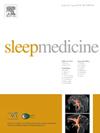Preliminary findings of DNA hypermethylation of MDGA1 in idiopathic restless legs syndrome
IF 3.8
2区 医学
Q1 CLINICAL NEUROLOGY
引用次数: 0
Abstract
Background
Both genetic and environmental factors contribute to the development of restless legs syndrome (RLS). Epigenetic mechanisms might play a vital role in RLS but remain underexplored. MDGA1, involved in synaptic inhibition, has been identified by genome-wide association studies as a potential risk gene for RLS. However, its role and underlying mechanisms in RLS are largely unknown.
Objective
To investigate the relationship between DNA methylation levels in the promotor region of MDGA1 and RLS susceptibility and phenotypes.
Methods
Two independent RLS cohorts (including three large RLS families) and healthy controls (HCs) were recruited. Clinical characteristics were recorded, and DNA methylation levels of CpG islands in the MDGA1 gene from peripheral blood mononuclear cells were measured. Associations between MDGA1 methylation (MDGA1m) and RLS phenotypes (age, sex, and family history) were also analyzed.
Results
A total of 62 idiopathic RLS (iRLS) patients (29 from Cohort 1 and 33 from Cohort 2) and 45 healthy controls (24 from Cohort 1 and 21 from Cohort 2) were included. MDGA1 methylation levels were significantly higher in iRLS patients compared to HCs. Among RLS families, both RLS patients and non-RLS family members showed hypermethylation compared to HCs. Moreover, a positive family history of RLS was associated with an increased risk of MDGA1 hypermethylation.
Conclusion
Our study identified hypermethylation of the MDGA1 gene in the peripheral blood of RLS cases, which may be linked to family history.

特发性不宁腿综合征中MDGA1 DNA超甲基化的初步发现
遗传和环境因素都有助于不宁腿综合征(RLS)的发展。表观遗传机制可能在RLS中发挥重要作用,但仍未得到充分研究。MDGA1参与突触抑制,已被全基因组关联研究确定为RLS的潜在危险基因。然而,其在RLS中的作用和潜在机制在很大程度上是未知的。目的探讨MDGA1启动子区DNA甲基化水平与RLS易感性和表型的关系。方法招募2个独立的RLS队列(包括3个RLS大家族)和健康对照(hc)。记录临床特征,并测量外周血单核细胞MDGA1基因CpG岛的DNA甲基化水平。MDGA1甲基化(MDGA1m)与RLS表型(年龄、性别和家族史)之间的关系也进行了分析。结果共纳入62例特发性RLS (iRLS)患者(队列1 29例,队列2 33例)和45例健康对照(队列1 24例,队列2 21例)。与hcc患者相比,iRLS患者的MDGA1甲基化水平明显更高。在RLS家族中,与hc相比,RLS患者和非RLS家族成员均表现出高甲基化。此外,阳性的RLS家族史与MDGA1超甲基化的风险增加有关。结论本研究发现RLS患者外周血MDGA1基因高甲基化,可能与家族史有关。
本文章由计算机程序翻译,如有差异,请以英文原文为准。
求助全文
约1分钟内获得全文
求助全文
来源期刊

Sleep medicine
医学-临床神经学
CiteScore
8.40
自引率
6.20%
发文量
1060
审稿时长
49 days
期刊介绍:
Sleep Medicine aims to be a journal no one involved in clinical sleep medicine can do without.
A journal primarily focussing on the human aspects of sleep, integrating the various disciplines that are involved in sleep medicine: neurology, clinical neurophysiology, internal medicine (particularly pulmonology and cardiology), psychology, psychiatry, sleep technology, pediatrics, neurosurgery, otorhinolaryngology, and dentistry.
The journal publishes the following types of articles: Reviews (also intended as a way to bridge the gap between basic sleep research and clinical relevance); Original Research Articles; Full-length articles; Brief communications; Controversies; Case reports; Letters to the Editor; Journal search and commentaries; Book reviews; Meeting announcements; Listing of relevant organisations plus web sites.
 求助内容:
求助内容: 应助结果提醒方式:
应助结果提醒方式:


